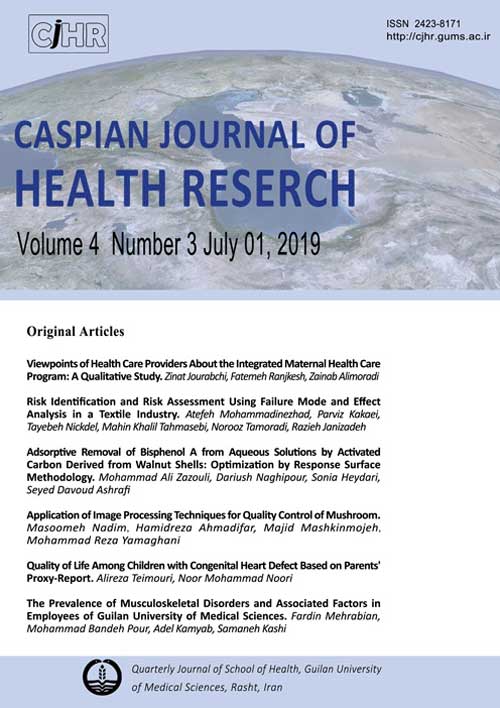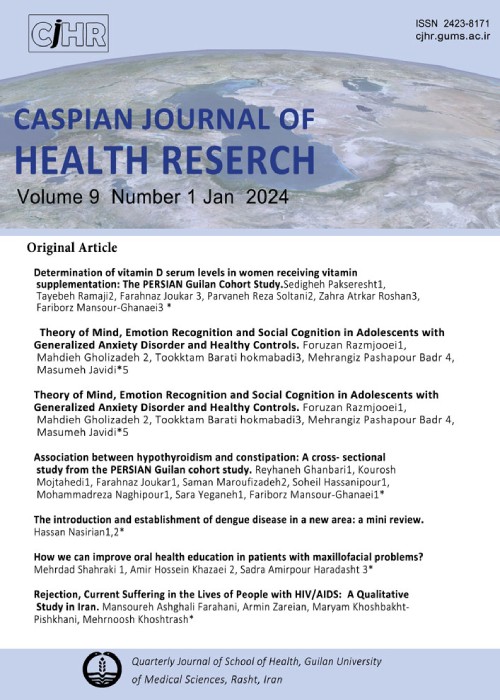فهرست مطالب

Caspian Journal of Health Research
Volume:4 Issue: 3, Sep 2019
- تاریخ انتشار: 1398/05/05
- تعداد عناوین: 6
-
Pages 54-59BackgroundMaternal health program is among the most important health services. Providing convenient and high quality services, improve the mothers' health and satisfaction. This study was aimed to determine Health care providers` Viewpoints about the Integrated Maternal Healthcare Program.MethodsThe present qualitative study was performed using content analysis method. Data were collected by a semi-structured interview with midwives, physicians and relevant administrators from health department of Qazvin University of medical sciences. Purposive sampling technique was continued until conceptual saturation of information. Data analysis was done simultaneously with data collection.ResultsData analysis showed three main themes of “program shortcomings”, “requirements for development” and “program facilitating points” along with ten subthemes.ConclusionIt seems that the quality of maternal health services is more favorable with new program compared to old program. But there are problems in the implementation such as long period between visits or delay in requesting sonogram in the first trimester. Therefore continuous re-evaluation and correction of program will improve quality of the program and subsequently maternal health.Keywords: Iran, Maternal Health Services, Prenatal care, Qualitative research
-
Risk Identification and Risk Assessment Using Failure Mode and Effect Analysis in a Textile IndustryPages 60-65BackgroundToday with growth of industry, occupational hazards are increasing proportionally. One of the most important parts of these industries are human resources, which face with many various hazards. The aim of this study was to conduct an assessment of potential hazards in the textile industry using Failure Mode and Effect Analysis (FMEA).MethodsThis cross-sectional study was conducted in the spinning sector of textile industry. FMEA as one of the systematic risk assessment technique applied to each unit of the spinning sector to find out potential failure mods and its effects. Risk priority number (RPN) was determined based on severity, detectability and occurrence of hazards. Then PRN were categorized into low-risk (RPN ≤ 89), moderate risk (RPN = 90-199), and high risk level (RPN ≥ 200).ResultsA total of 58 risk were found in 6 units of the spinning sector. 38% were found to be at high level 45% at middle level and 17% at low level. The packing unit, had the highest risk compared to other units. Lifting heavy loud in the packing unit has the highest RPN (384) and bobbin falling down in the ring unit has the lowest RPN (24).ConclusionThis study revealed that more than 80% of detected risk were unacceptable that showed hazardous condition for workers in textile industry. Lifting heavy louds followed by bobbing falling were the most hazardous task in this industry. The implementation of safety measures such as training programs, engineering and management controls were recommended.Keywords: Failure Mode, Effect Analysis, Textile industry, Risk assessment
-
Pages 66-71BackgroundPresence of bisphenol A in water resources is harmful for health of human beings. Therefore, it should be addressed to eliminate and prevent its contamination. The aim of this study was to evaluate the activated carbon adsorbent efficiency of walnut shells in removing bisphenol A from aqueous solutions.MethodsIn this study, adsorbent preparation using walnut shells was performed according to standard methods. The independent variables are pH, initial concentration of bisphenol A and adsorbent dose. The surface response method was used to design the experiment and determine the optimum adsorption conditions.ResultsThe results showed that output of removal rate of the contaminating increased at a dose of 1.5 g, pH = 3, and initial concentration of bisphenol A was 40 mg/L. Also, the analysis of variance of data revealed that the model obtained from the response surface method was statistically significant.ConclusionBased on the results using walnut shell as an inexpensive and available adsorbent, it is possible to remove up to 97% of the bisphenol A from the aqueous solution by creating optimal conditions.Keywords: Bisphenol A, Waste water, Activated carbon, Walnut shell, Response surface methodology
-
Pages 72-75BackgroundMushroom is one of the sources for protein supply, and it has taken into consideration among most countries in the world due to its rich medicinal features. Nowadays, due to the mechanization of traditional methods and quality control of products, it is possible to evaluate the quality of mushrooms with the help of image processing techniques.MethodsIn this study, image processing systems were used to determine the appearance quality of mushrooms. Using the properties of color, area, weight, and volume obtained from data mining techniques, artificial neural networks and fuzzy logic system mushroom quality was evaluated.ResultsA total of 250 images in three categories of defective, moderate were assessed. The correct detection rate by the image processing system was 95.6%.ConclusionThe results of this study showed the optimum performance of image processing systems for assessing the quality of mushrooms. The superiority of image processing systems compared to traditional method can be observed in the quality of increased efficiency and high accuracy, as well as the reduction of costs and destructive effects in the production and packaging of food products.Keywords: Image processing, data mining, Mushroom quality, neural network, fuzzy logic
-
Pages 76-81BackgroundThe aim of this study was to evaluate quality of life among children with congenital heart defect (CHD) and to determine the associated factors based on parents' proxy-reports.MethodsThis cross-sectional study was conducted on 263 children with CHD using inventory of PedsQoL 3.0. The PedsQoL 3.0 scores reported by parents of children. The association between quality of life and patients characteristics were assessed using multivariate linear regression method.ResultsThe mean score of total quality of life was 51.6 (SD=9.68). Re-hospitalization cost was high for the majority of families (46.8%). Heart problem scale of quality of life was significantly associated with mothers’ education and age. On treatment scale, only age had significant correlation. Physical appearances, was associated with number of household and type of diseases. Anxiety was significantly associated with age and re-hospitalization status. Cognition correlated with household numbers and age. Total quality of life was significantly associated with income, age and number of household.ConclusionThe study found some important predictors of quality of life in children with CHD. The results can be used for further educational and supportive programs for these patients.Keywords: Children, Congenital Heart Defects, Quality of life
-
Pages 82-85BackgroundMusculoskeletal disorders are one of the most common and costly problems associated with work, caused by disruption or damage to one of the organs or tissues of the body. The aim of this study was to determine the prevalence of musculoskeletal disorders, cumulative disorder and its relationship with individual characteristics in Guilan University of Medical SciencesMethodsThis descriptive, analytical and cross sectional study was conducted in 1396. The society and the research environment were 336 employees of Guilan University of Medical Sciences. The Nordic Questionnaire (NMQ) was used to analyze the data using descriptive statistics and SPSS16 software.Results41% of the study population had symptoms of musculoskeletal disorders in the neck region and 34.6% in the shoulder region And 65.4% of them had no symptoms of disturbances. There is a significant relationship between the prevalence of musculoskeletal disorders in the shoulder and elbows with computer work. Also, the prevalence of musculoskeletal disorders in the waist region was significantly correlated with BMI.ConclusionSince musculoskeletal disorders in the research community are high and due to the role of these disorders in reducing human resource productivity, managers should provide the ways for prevention and reduction of musculoskeletal disordersKeywords: Skeletal, Muscular, Cumulative, Individual Characteristics


